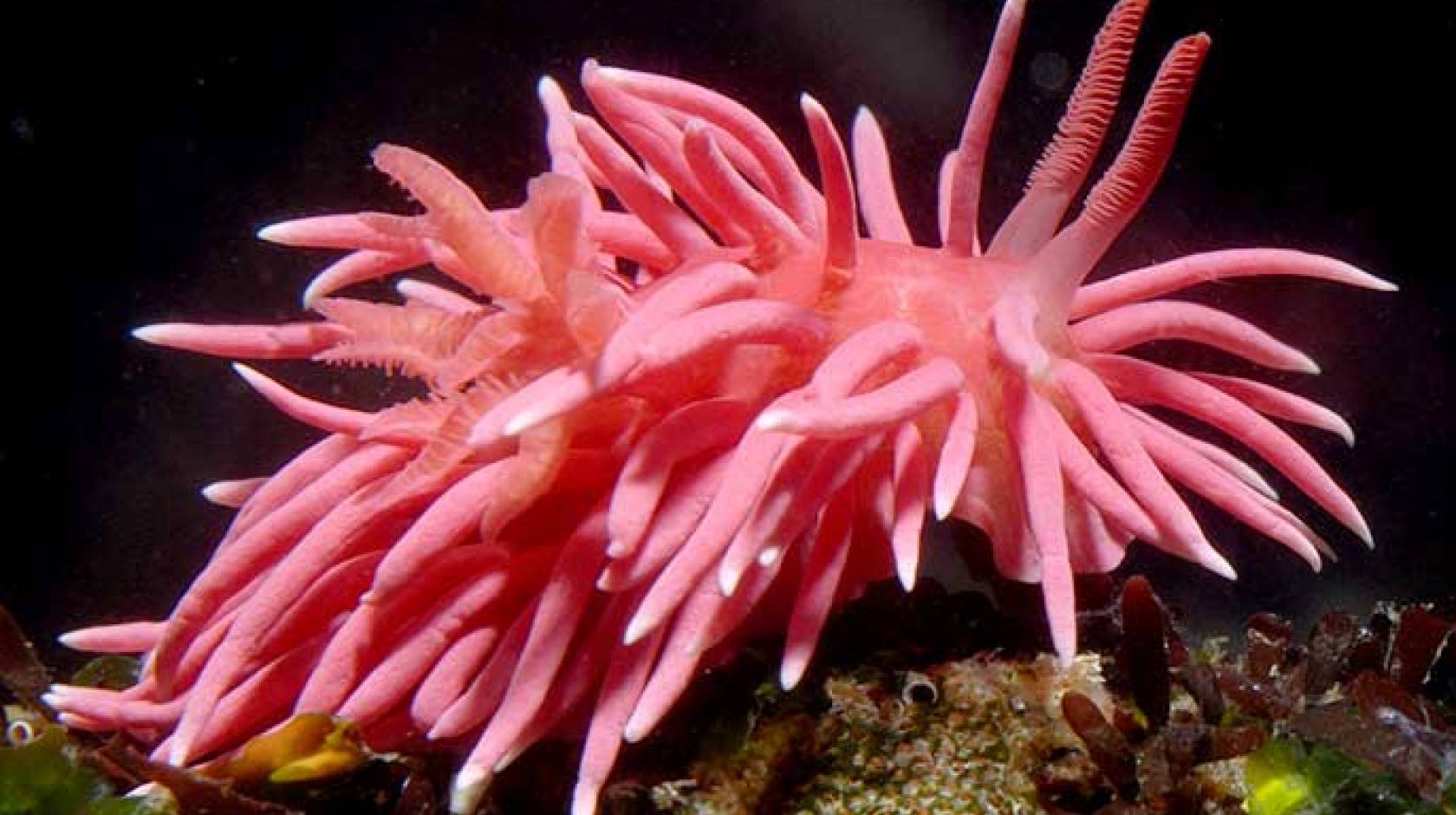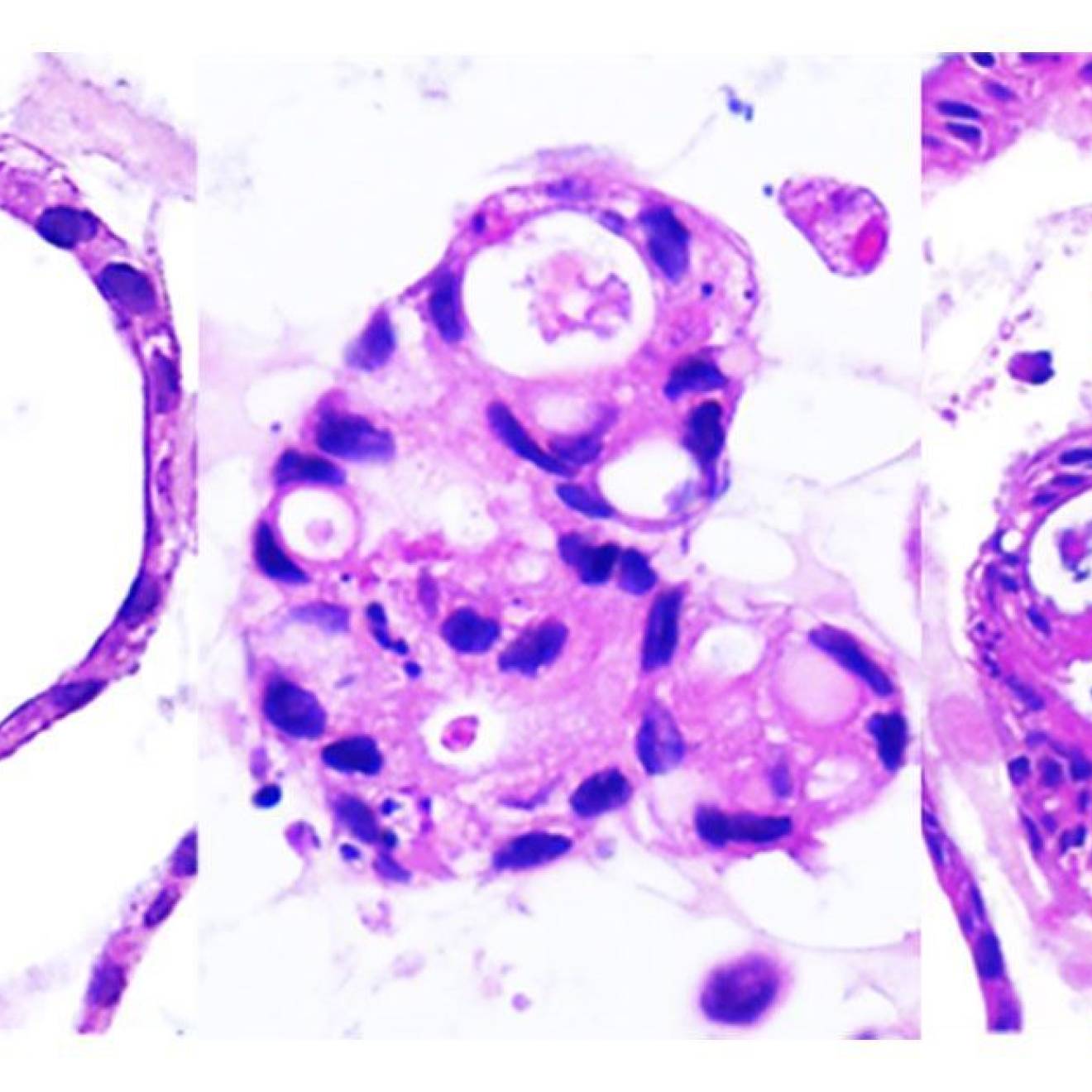Julie Cohen and Tim Stephens, UC Santa Barbara and UC Santa Cruz

The warm ocean temperatures that brought a green sea turtle to San Francisco in September and other southern species north of their usual ranges on the Pacific coast have triggered a population explosion of a bright pink, inch-long sea slug in tide pools along the central and northern California coast.
The Hopkins' Rose nudibranch (Okenia rosacea) is locally common in southern California but sporadic in central California and rare north of San Francisco. In the past few weeks, however, researchers from UC Santa Barbara, UC Santa Cruz, Bodega Marine Laboratory and the California Academy of Sciences have reported densities of up to dozens per square meter in tide pools from San Luis Obispo to Humboldt counties. These are the highest numbers and northernmost records of this species seen since the strong El Niños of 1998 and 1983.
Only this year, there’s been no El Niño to speak of. Zoologist Jeff Goddard, a project scientist at UC Santa Barbara's Marine Science Institute and research associate at the California Academy of Sciences, equates the current population bloom of Hopkins’ Rose to the one he observed on the Central Coast starting in early 1977.
“Last week, during routine monitoring near Morro Bay, I was astonished by the numbers of Okenia present,” Goddard said.
"We haven't seen anything like it in years," said John Pearse, professor emeritus of ecology and evolutionary biology at UC Santa Cruz. "These nudibranchs are mainly southern species, and they have been all but absent for more than a decade."
Surveys

Photo courtesy of Jeff Goddard
Pearse, Goddard and other researchers have been conducting surveys of nudibranchs at study sites along the California coast for decades. "What makes this event especially exciting for us is that in 2011 we published a paper in which we predicted that oceanographic conditions like we are now experiencing would be marked by heavy recruitment of these and other nudibranchs. It's just wonderful to see the prediction coming true," Pearse said.
The research team includes Pearse's wife Vicki Pearse, a research associate at UC Santa Cruz's Institute of Marine Sciences (IMS); Terrence Gosliner, senior curator at the California Academy of Sciences; and IMS researcher Gary McDonald. Steward Shultz, the first author of the 2011 paper in Limnology and Oceanography, is at the University of Zadar, Croatia.
Pearse noted that the study relied in part on data from Goddard's senior thesis research in the mid-1970s, when he worked with Pearse as a UC Santa Cruz undergraduate. "It is always pleasing to me to see our students' senior theses end up in publications," Pearse said.
“I remembered 1977 and decided to sample my old study sites on either side of Monterey Bay," said Goddard. "Both also had exceptionally abundant Okenia, plus other southern nudibranchs not typically present, including at one site the stunning purple and orange Spanish Shawl. We’ve also had a reliable report of California Sea Hares on the outer Sonoma coast, far north of the usual range of this large herbivorous sea slug.”
Pacific Decadal Oscillation
The 1977 bloom occurred also during a weak El Niño and coincided with a major climate shift in the eastern Pacific Ocean known as the Pacific Decadal Oscillation. That shift marked the beginning of more than two decades of coastal water temperatures that were elevated compared to the preceding 30 years, triggering range shifts in numerous coastal species, including gastropods, barnacles, fish, and dolphins. This triggered range deviations in numerous coastal species, including gastropods, barnacles, fishes and dolphins.
During those warm decades, fluctuations in the abundance of intertidal adults of Hopkins’ Rose and other nudibranchs in Central California were driven by regional oceanographic influences on currents and larval recruitment. This is what Goddard, Pearse, Schultz, Gosliner and others argued in the 2011 paper. They predicted high recruitment of these nudibranchs when warm temperatures, northward-directed currents and weak upwelling occur — and that is exactly what is happening now.
Like the previous population explosions of Okenia, the current bloom has also been accompanied by other sea slugs normally found farther south, including the bright purple and orange Spanish shawl (Flabellina iodinea) and the California sea hare (Aplysia californica). While southern species of fish, seabirds and marine mammals also have appeared in Northern California as adults, nudibranchs differ in being carried as microscopic planktonic larvae on the coastal currents northward and onshore. When the larvae have fed and grown large enough (typically over a month or two), they settle to the bottom and, if they encounter the prey of the adults, they metamorphose into juvenile slugs.
Pink pigmentation
The prey for Hopkins' Rose nudibranch is a rose-colored encrusting bryozoan on which it feeds during its entire benthic life and from which it derives its pink pigmentation. This perennial bryozoan is locally abundant on the Pacific coast up into British Columbia. The nudibranch's distribution, therefore, is not limited by the availability of its prey but likely by a combination of cold temperatures and ocean circulation patterns.
Because they are fast-growing, live for a year or less, and move little as adults, these nudibranchs are potentially useful in tracking relatively rapid changes in ocean conditions. The current population bloom has the researchers wondering if the nudibranchs are signaling, as a sort of zoological semaphore, another major climate shift from cold to warm coastal waters.
"Although the index values of the Pacific Decadal Oscillation have really jumped the past few months, it's probably still too early to say, at least until we become better at decoding the signals," Goddard said. "However, if a decadal shift is in progress, there's a good chance the next El Niño will be a major event, on par with the 1983 and 1998 events, and bring with it myriad surprises from the south."

